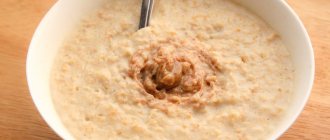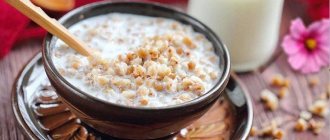Proper feeding of porridge is the key to your child’s health and well-being. After all, porridge contains a large amount of vitamins - so necessary for your baby for growth and development. Therefore, it is very important to create the right diet and choose the optimal cereal complementary foods. As a rule, porridge is the very first complementary food for a child, so parents treat its choice with full responsibility. Before you start complementary feeding, it is recommended to draw up a sample menu for your child, and most importantly, decide for yourself: will you cook the porridge yourself or buy it ready-made in the store. If you have questions about cereal feeding, this material will help you find the answers.
Which cereal porridge to start complementary feeding with?
In the 1st week, you begin to give your child ready-made, store-bought porridge that does not contain milk (Baby, Heinz, etc.). Information on how to dilute porridge for the first feeding is on each package. It is recommended to increase its volume from 1-2 teaspoons to 150 ml. After the porridge, you supplement your baby with breast milk.
In the 2nd week, you can gradually replace dairy-free porridge with milk. During this period, it is necessary to carefully monitor the tolerance of the new food product.
The next two weeks are set aside for complete adaptation to the new cereal food and control of its absorption. From the 3rd week, 3 g (1/2 teaspoon) of butter is added to the porridge. Until the volume of complementary foods reaches 150 g, it is better to supplement the baby with breast milk.
Before you start feeding porridge, you should understand that this can lead to a decrease in lactation. In this case, from the 4th week, instead of breastfeeding, you can offer the baby an adapted formula for children in the second half of the year, juice or fruit puree. In this case, the mother needs to decide whether she will stimulate lactation or introduce formula milk into the menu. It is better to discuss this issue with your pediatrician.
The importance of breastfeeding
Breastfeeding is considered the best option. Mother's milk is the most adapted food product for young children. No baby porridge can beat mother's milk. Considering the importance of breast milk, WHO/UNICEF experts developed a document - “Protection, promotion and support of breastfeeding practice”. It outlines the basic recommendations for successful breastfeeding. There are reasons that lead to a lack of breast milk in a mother. This problem has a medical terminology - hypogalactia . There are many reasons leading to the replacement of breast milk with porridge. More details about this can be found in the document “National program for optimizing the feeding of children in the first year of life in the Russian Federation.”
No baby porridge can beat mother's milk.
Baby food consists of two main parts:
- milk formulas;
- complementary foods.
Let's look at each of them in more detail.
How to start feeding porridge: menu
How to introduce porridge into complementary foods at 5 months - an approximate menu of cereal complementary foods for a child 5.5-6.5 months old:
| Feeding | Watch | Type and quantity of food | |
| 1st day of introducing complementary foods | 14th day of introducing complementary foods | ||
| 1st | 7.00 | Breast milk - 200 ml | |
| 2nd | 11.00 | 2 tsp. (10 g) instant rice porridge "Baby" +190 ml breast milk | 150 g Baby rice porridge + 1/2 tsp. butter + 50 ml breast milk (fruit puree or juice) |
| 3rd | 15.00 | Breast milk - 200 ml | |
| 4th | 19.00 | Breast milk - 200 ml | |
| 5th | 23.00 | Breast milk - 200 ml | |
Recommended nutritional correction when introducing porridge into complementary foods for a baby:
- Aquadetrim - 1 drop (500 IU) 1 time per day (prevention of rickets).
- Pulpy apple juice - 60 ml between feedings or after cereal feeding.
- Applesauce - 60 g in between feedings or after cereal feeding.
When and in what quantity can you try milk porridge for the first time while breastfeeding?
Many young mothers add milk porridge to their menu already in the first month after giving birth, but pediatricians do not recommend rushing so much. The fact is that the baby’s digestive system at this age is not yet strong enough, and therefore often reacts incorrectly to unfamiliar foods in the mother’s diet.
It is better to postpone the introduction of milk porridge until the baby is two or three months old.
By this point, the child will have time to get acquainted with many products in the mother’s diet and will be able to assimilate new food normally.
At the first tasting, a young mother should eat no more than 1 tablespoon of milk porridge and wait a couple of days. If during this time no spots have appeared on the baby’s skin, his stool has not changed consistency and the baby behaves calmly, then you can increase the amount of porridge.
A nursing mother is allowed to eat no more than 200-300 grams of ready-made milk porridge per day.
If the porridge causes allergies or digestive problems, then its introduction is postponed for a month or two to allow the baby’s body to grow a little.
Introducing porridge into complementary foods: we prepare it ourselves
If the child is healthy and has no allergies, the mother can cook everything on her own.
How to prepare porridge for the first feeding: cook 5% liquid porridge from rice cereal, i.e. 5 g of cereal will require 100 ml of half-and-half milk. Half-and-half milk is cow's milk diluted with vegetable broth or water in a 1:1 ratio. According to the standard scheme, the amount of porridge is increased to 150 g per week.
In the 2nd week, 5% porridge with half-and-half milk is replaced with porridge with whole milk. From the 3rd week, the density of complementary foods is increased: per 100 g of milk, take 1.5 teaspoons of cereal (8% porridge). From the 4th week, porridge is cooked at the rate of 2 teaspoons (10 g) of cereal per 100 ml of cow's milk (10% porridge) and add 3 g (1/2 teaspoon) butter.
Feeding porridge during breastfeeding should certainly be tasty, so sugar is always added at the rate of 5 g per 100 ml of milk. Thus, one month is allotted for introducing porridge into the diet. At the beginning of a diet change due to energy-rich complementary foods, the feeding rhythm may become uneven. If everything is done correctly, this period lasts no more than 7-10 days.
However, ready-made cereals are easier to use; they contain complexes of vitamins, minerals and skim cow's milk. It is recommended to introduce homemade porridge with whole cow's milk into the diet after the 8th-9th month. By this age, the child’s barrier function of the digestive tract has stabilized, and he has time to adapt to infant formula.
Despite the vast selection of instant ready-made porridges, do not rush to diversify the menu, even if your little one really liked the first porridge. Porridges from a mixture of cereals are given after the 8th month, porridges with various additives (muesli, nuts, chocolate, exotic fruits) are introduced into the diet no earlier than 10-11 months.
Many baby feeding guides indicate how to introduce porridge into complementary foods, increasing the amount over time. This is due to an increase in the capacity of the stomach and the formation of its distensibility. Therefore, by the 7th month of life, it is allowed to give 180 g of porridge and 45-50 ml of juice or mixture per feeding. From 9 months to 1 year, the amount of porridge feeding in combination with juice, an adapted formula for children in the second half of the year or fruit can be up to 200 g per feeding.
The average standard minimum value remains the ratio: 75% solid complementary feeding (150 g of porridge) and 25% (50 ml) liquid (juice or mixture). In the future, the amount of solid complementary feeding may be greater: 170-180 g (75%) porridge + 50 ml (25%) juice (mixture) at 7-8 months and 200 g (75-80%) porridge + 50 ml (25% ) juice (mixture) after 9 months.
Milk formulas
Adapted are mixtures presented in liquid or powder form, which are made on the basis of cow's milk and the milk of other farm animals. At the same time, they are used as a replacement for mother's milk. Thanks to the modern level of food technology, these products are closest to the composition of mother's milk, which allows the baby to receive all the necessary nutrients.
There are several types of adapted mixtures:
- "Elementary". Used from birth to six months.
- "Subsequent." Apply from 6 months to one year.
- "Universal". Suitable for children from birth to one year.
The content of all necessary substances in these mixtures meets international standards.
Among the “initial” mixtures one can highlight: HiPP PRE, HiPP 1, Nutrilon 1, Humana PRE, Humana 1, Nan 1, Enfamil 1 and others.
“Follow-up” milk formulas include: HiPP 2, Humana 2, Nutrilon 2, Nan 2, Enfamil 2 and others.
There are also many other types of baby cereals that are used for various pathologies in children. You can find out more about them in our article.
Parents often ask the question: “How to choose baby food?” This question can be answered quite easily.
Indicators of the correct choice of mixture will be:
- a good appetite;
- no vomiting or bowel movements;
- no problems with the baby's skin;
- sufficient weight gain.
Which porridge is best for baby's first feeding?
The range of ready-made instant cereals for feeding babies in their first year of life is quite extensive. They are prepared from environmentally friendly raw materials with mandatory control for the content of pathogenic bacteria, balanced in composition, enriched with microelements and vitamins.
The pediatrician determines which porridge to start complementary feeding with, taking into account the state of the baby’s digestive tract, his physical and motor development, individual characteristics and previous diseases.
Instant (not requiring cooking) porridges can be divided into dairy and dairy-free. Dairy-free cereals are usually used when introducing complementary foods with a subsequent transition to dairy.
Allergists also give advice on which porridge is best for first feeding, recommending hypoallergenic dairy-free gluten-free porridges (rice, corn and buckwheat) if an allergy to cow's milk protein or cereals is detected.
Depending on the degree of adaptation of the ingredient composition to the characteristics of the child’s digestive tract, porridges have been developed that are recommended for children 4, 5, 6 and 8 months of age. The packaging must indicate the age at which they can be given.
Porridges for children 4 months of age can be considered the most gentle and digestible. Therapeutic and preventive porridges are also produced, which include low-allergenic porridges enriched with microelements (iron, iodine, zinc) and prebiotics. They are intended for children with manifestations of allergies, dysbacteriosis and anemia.
Can buckwheat be harmful?
Buckwheat is a very healthy product, but everything is good in moderation.
- Overconsumption of this cereal may have a negative impact on people with kidney failure.
- Diabetics should also use this product carefully, as the starch in the composition can increase blood glucose levels.
- Mothers who have problems with blood pressure also need to be wary of buckwheat, as consuming it can dilate blood vessels, which will aggravate the situation.
For nursing women, it is permissible to eat buckwheat 2-3 times a week. A serving should not exceed 200 g of cooked cereal.
Despite all the benefits of the product, we must not forget that nutrition during breastfeeding should be varied, so there is no need to give preference to one thing.
How to enter correctly into the menu
You need to eat any product, even the most harmless one, in a small portion in order to test the small organism’s reaction to it. This also applies to buckwheat.
It is important to remember that during lactation, any new product must be introduced gradually. The dosage can be increased only if the baby has a normal reaction to the product.
When starting to eat cereal, you must follow certain rules:
- first you need to eat two tablespoons and observe whether the little one has colic, bloating and indigestion;
- if the child does not take buckwheat, put it aside and try again in a few months;
- first cook the buckwheat in water, without butter;
- if the baby’s reaction is normal, you can eat 150 grams per day;
- When the baby grows a little, add fruit to the porridge.
If you start the day with buckwheat porridge, you can provide your body with nutritious vitamins and satisfy your hunger for a long time. Consuming it regularly in the morning will allow you to get a good mood and strength for the whole day. It will be useful to prepare buckwheat porridge by adding meat or mushrooms, vegetables and herbs.
When purchasing, you need to choose high-quality cereals, be sure to look at the expiration date. Before cooking, rinse and remove dark grains of sand.
Rules for introducing buckwheat into the diet of a nursing mother
All products, including buckwheat, are introduced into the menu gradually. It is important to monitor the baby's reaction in order to identify allergens at an early stage and avoid them in the future.
A food diary will help with this: they record what, when and in what quantity the mother ate and how this affected the child’s well-being.
How often to use and in what form
Start eating buckwheat with a few tablespoons a day. If after 24 hours the baby does not experience any undesirable reactions (abnormal bowel movements, bloating, redness), the portion is doubled. This procedure is repeated until the mother eats 150 g of buckwheat porridge per day.
The optimal frequency is 3-4 times a week; on other days the product is replaced with other cereals, pasta, and potatoes.
Recipes with buckwheat for nursing
The neutral taste of buckwheat provides a wide field for culinary imagination. Cereals can be an independent dish, a side dish, a seasoning for soups, and even a dessert.
Buckwheat soup
We offer a lighter, lean version of the dish. You can use a second chicken or beef broth if desired.
Ingredients:
- 1.5-2 liters of water;
- 100 g buckwheat;
- 2 potatoes;
- 1 carrot;
- 1 tbsp. l. vegetable oil;
- 1 bay leaf;
- salt and herbs - to taste.
Preparation:
- Sort the grains and rinse until the water becomes clear. Peel the potatoes and cut into cubes.
- Place buckwheat and potatoes into boiling water. Cook for 15-20 minutes.
- Grate the carrots and simmer in vegetable oil until soft. Add to soup and leave over medium heat for another 5 minutes.
- Season the soup with salt and bay leaf. Let it brew.
- Serve with finely chopped greens.
Buckwheat with beef and vegetables in a slow cooker
For sustainable lactation, a nursing mother needs protein, and not only vegetable protein. Beef is preferable during this period - it acts as an additional source of well-absorbed iron.
The recipe saves time - place the ingredients in the multicooker bowl, set the mode and do other things while the device prepares the dish.
Ingredients:
- 250 g beef;
- 1 tbsp. buckwheat;
- 1 carrot;
- 2 sweet peppers;
- 0.5 zucchini;
- 2 tbsp. l. vegetable oil;
- 2 tbsp. water;
- salt and herbs - to taste.
Preparation:
- Wash the beef, dry it and cut into small slices. Fry on vegetable oil for 10 minutes on the “Fry” mode without closing the multicooker lid. Thanks to the resulting crust, the liquid will be “sealed” inside the pieces, and the meat will be more juicy.
- Add grated carrots, diced zucchini and bell peppers. Continue cooking in the “Frying” mode for another 5 minutes, but with the lid on.
- Add sorted and washed buckwheat to the meat and carrots, add salt and water. Mix everything thoroughly. Depending on the model of the device, set the “Grain” or “Buckwheat” mode. Approximate cooking time is 35 minutes.
- 5 minutes before readiness, add chopped herbs.
This dish will be more healthy if the meat is cooked separately from the grains - in this case, we reduce the amount of water by half. Serve the finished beef with steamed buckwheat.
Steamed buckwheat
These buckwheat porridge cutlets with minced meat are good both hot and cold. Steamed buckwheat is tender and nutritious.
Ingredients:
- 1 cup pre-steamed buckwheat;
- 500 g turkey meat;
- 1 egg;
- salt - to taste.
Preparation:
- Wash the turkey and cut into pieces. Grind the meat in a blender or pass through a meat grinder.
- Add buckwheat porridge, egg and salt. To stir thoroughly.
- Form cutlets. To do this, pinch the minced meat with your hands soaked in cold water and beat it a little, throwing it between your palms - this will help get rid of excess moisture and the buckwheat will keep its shape better.
- Place the cutlets in a double boiler or in a special multicooker form. Cook for 30 minutes.
Turkey is an excellent substitute for minced chicken. For juiciness, you can add half an onion, grated.
Buckwheat casserole with cottage cheese
This dish will not take much time, but will add variety to your usual diet. The casserole can be served for breakfast or afternoon snack.
Ingredients:
- 1 tbsp. steamed buckwheat;
- 200 g cottage cheese;
- 2 eggs;
- 100 g sour cream;
- sugar, salt - to taste.
Preparation:
- Rub the cottage cheese through a sieve and mix with the prepared buckwheat porridge.
- Beat sour cream and eggs. Salt and sweeten to taste.
- Mix both masses and place in a baking dish.
- Cook in an oven preheated to 180°C for 15-20 minutes.
Baked apples with buckwheat
This dessert is allowed from 3-4 months of lactation, when the mother can afford a small portion of nuts and honey.
In an earlier period, you can do without these ingredients, but with them the dish tastes better.
Ingredients:
- 2 green apples (Antonovka, Granny Smith, Golden);
- 2-3 tbsp. l. steamed buckwheat;
- 2 tbsp. l. chopped walnuts;
- 1 tbsp. l. raisins;
- 2 tbsp. l. honey
Preparation:
- Soak raisins in cold water.
- Wash the apples and dry them. Using a teaspoon or a special tool, carefully remove the core.
- Mix buckwheat porridge with raisins, nuts and honey. Stuff apples with filling.
- Bake at 180°C for 30 minutes. The apples should be golden and the filling should be crispy.
Walnuts are one of the first to be introduced into a nursing mother's diet (in the 2-3rd month of lactation), because they are less allergenic than hazelnuts, almonds and others. A handful of dried fruits a couple of times a week will not cause harm even at first.
Buckwheat milk
In the first couple of months of breastfeeding, whole cow's milk is prohibited. Buckwheat milk drink is a great alternative. It can be added to tea, porridge or drunk on its own.
Ingredients:
- 60 g green buckwheat;
- 300 ml boiled water.
Preparation:
- Sort and rinse the cereals, pour two glasses of clean cold water and leave to swell for 5-6 hours. You can do this overnight, but it is better to periodically change the water to fresh water so that the cereal does not sour.
- Rinse the infused buckwheat again. Let the water drain.
- Beat in a blender at high speed, adding boiled cold water in small portions.
- Strain the resulting mass through a sieve or double folded gauze. Buckwheat milk is ready.
- It can be stored in the refrigerator for no more than 12 hours.
How to cook buckwheat porridge for babies
Before you prepare buckwheat porridge for your baby, make sure that the cereal is clean. Place a teaspoon of grains in your palm and sort through. Then rinse several times in cold water and let dry. Grind the dry grains in a coffee grinder or blender. You can cook porridge from buckwheat flour, but it is better if you are sure that it is made from pure and high-quality grain.
- Porridge for a baby who does not yet know how to chew should be thin and puree-like; this consistency can be achieved by observing the ratio of 5 g of dry cereal (a level teaspoon) per 100 ml of water.
- After 8 months, a child can add boiled vegetables to the porridge - zucchini, carrots, pumpkin.
- From 9-10 months it is advisable to add ground turkey, rabbit, chicken or veal. Other types of meat are not recommended for young children. By-products can be introduced into the diet no earlier than three years of age.
- You can salt and sweeten buckwheat from one year of age.
Useful properties of cereals
Any doctor, from a pediatrician to a nutritionist, when asked whether buckwheat is ok, almost always answers positively. Buckwheat is a very nutritious, dietary, low-calorie cereal. It contains a lot of fiber and carbohydrates, which are difficult to digest. Porridge provides mother and child with all important microelements and is considered the most healthy. It has a lot of advantages:
- does not contain gluten and allergens;
- allowed in the first month of breastfeeding;
- easy for digestion;
- it is not treated with chemicals;
- anemia medicine;
- helps strengthen bones, hair and nails;
- helps with depression;
- dietary cereal;
- regulates hormones;
- increases immunity;
- medicine for constipation.
The benefits of buckwheat are very great. It contains iodine and nickel, copper and iron, phosphorus and cobalt. It contains a lot of vitamins B, E and PP. Cereals also contain protein, fiber, and healthy carbohydrates. Cereals are very filling and high in calories, but despite this, they help you lose weight after childbirth.
Calorie table for buckwheat with additives
| dish with buckwheat | number of calories in a dish |
| buckwheat porridge on water | 110 |
| buckwheat porridge with butter | 130-135 |
| buckwheat porridge with milk and sugar | 190 |
| buckwheat with mushrooms | 70-90 |
| buckwheat with chicken and vegetables | 150-160 |
Buckwheat helps maintain blood sugar levels and helps prevent diabetes. When consuming buckwheat, you can normalize blood pressure, rid the body of harmful toxins and cleanse blood vessels of cholesterol. Cereals in the diet are an excellent prevention of cardiovascular diseases. All these beneficial substances play a major role for the full development and growth of the baby. With the help of buckwheat, you can increase lactation; to do this, you need to fry it a little and eat it with butter and milk.
For a nursing mother, buckwheat porridge is a storehouse of nutrients that she and her baby need. Most experts recommend consuming this cereal daily during lactation.











